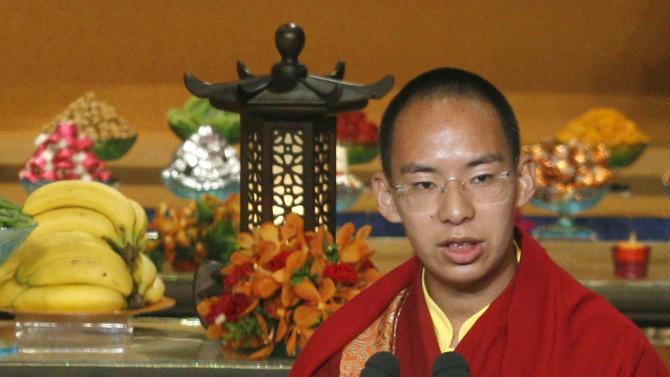TIBET CONSCIOUSNESS – RED CHINA’S POLICY OF SUBVERSION
TIBET CONSCIOUSNESS – RED CHINA’S POLICY OF SUBVERSION
CONSCIOUSNESS – RED CHINA’S PANCHEN LAMA IS A POLITICAL APPOINTEE.
GYALTSEN NORBU, THE 11th PANCHEN LAMA SYMBOLIZES RED CHINA’S POLICY OF
SUBVERSION.
Subversion means to undermine or corrupt established
institutions and belief systems using people who act as figures of
authority or of importance that followers can easily recognize. Most
Tibetan Buddhists can easily recognize a person known as ‘Panchen Lama’.
Red China’s policy of Subversion becomes very apparent in the manner in
which Red China appointed a Panchen Lama without any concern for
Tibet’s true Cultural Institutions. Tibet demands Red China to return
true or real 11th Panchen Lama.
Rudranarasimham Rebbapragada
Ann Arbor, MI 48104-4162 USA
SPECIAL FRONTIER FORCE
REUTERS
Tue Dec 8, 2015 8:25am EST
China’s Tibet party boss urges senior monk to shun Dalai Lama
BEIJINGTudeng Kezhu, a Tibetan delegate, touches the hand of
Gyaltsen Norbu, the 11th Panchen Lama and a delegate, with his forehead
during the opening session of the Chinese People’s Political
Consultative Conference (CPPCC) at the Great Hall of the People in
Beijing, March 3,…
Reuters/Jason Lee/Files
BEIJING China’s Communist Party boss in Tibet has urged the
Panchen Lama, the second-highest figure in Tibetan Buddhism, to reject
the Himalayan region’s exiled spiritual leader, the Dalai Lama, state
media said on Tuesday.
Controversy surrounds the position of the Panchen Lama since
the boy the Dalai Lama named as the reincarnation of the leader
disappeared when he was six years old.
The fate of the missing Panchen Lama, one of China’s most
zealously guarded state secrets, is just one area of contention between
China and the Dalai Lama over Tibet, and continues to worry many
Tibetans.
Tibetan Buddhism holds that the soul of a senior lama is reincarnated in the body of a child on his death.
The Dalai Lama and China’s officially atheist Communist Party
have repeatedly tussled over who has final authority on the issue of
reincarnation.
China’s Communist Party has long maintained that the Dalai
Lama’s choice, Gendun Choekyi Nyima, now 26, is not the real Panchen
Lama, and in 1995, the government selected Gyaltsen Norbu as the 11th
Panchen Lama.
Chen Quanguo, the party secretary of Tibet, said he hoped
Beijing’s Panchen Lama would “unswervingly walk with the party” and
safeguard national unity, the official Tibet Daily said.
“Resolutely draw a clear line between the 14th Dalai Lama and
firmly reject all subversive separatist activities,” Chen told the
Panchen Lama in the Tibetan city of Shigatse during a meeting on Monday
marking 20 years since the monk’s investiture.
“Tibetan Buddhism is at its best period of development in
history and religious circles and believers enjoy full religious
freedom,” the paper quoted Beijing’s Panchen Lama as telling Chen.
Tibet’s exiled leadership in India said Beijing’s bid to
involve itself on the issue of reincarnation had no moral or legal
standing.
“Beijing authorities or the atheist communist party of China
have neither legitimacy nor credibility on this matter,” Lobsang Sangay,
the political head of the government-in-exile, based in the northern
hill town of Dharamsala, told Reuters.
The 80-year-old Dalai Lama fled to India after a failed
uprising against Chinese rule in 1959. Beijing says he is a violent
separatist but the monk denies espousing violence and says he only wants
genuine autonomy for Tibet.
The Chinese government sees the appointment of the next Dalai
Lama as key to consolidating state control over Tibet, where separatist
movements have flared since the 1950s.
Tibetans fear Beijing will use the issue of the Nobel peace
laureate’s eventual death and succession to split Tibetan Buddhism, with
one new Dalai Lama named by exiles and one by the government.
Beijing insists it must approve the next Dalai Lama, though the title’s current holder has said the role could end when he dies.
(Reporting by Michael Martina; Additional reporting by Abhishek Madhukar in DHARAMSALA; Editing by Clarence Fernandez)
THOMSON REUTERS



Consciousness. Red China’s Policy of Subversion. 20th Anniversary of
Panchen Lama Enthronement on December 09, 2015. Gyaltsen Norbu is Symbol
of Subversion.

Consciousness. Red China’s Policy of Subversion. 20th Anniversary of
Panchen Lama’s Enthronement on December 09, 2015. Gyaltsen Norbu is
Symbol of Subversion.




Consciousness – Red China’s Policy of Subversion. Red China officially
appointed the 11th Panchen Lama, Gyaltsen Norbu, a Symbol of Subversion.


Consciousness – Red China’s Policy of Subversion. 20 years after
Disappearance, Tibet wants China to Return True or Real Panchen Lama.

Consciousness – Red China’s Policy of Subversion. 20 years after
Disappearance , Tibet wants Red China to return True or Real Panchen
Lama. Gyaltsen Norbu is Symbol of Subversion.

Consciousness – Red China’s Policy of Subversion. The 11th Panchen
Lama, Gyaltsen Norbu is Symbol of Subversion of Tibetan Cultural Belief
Systems.
Advertisements